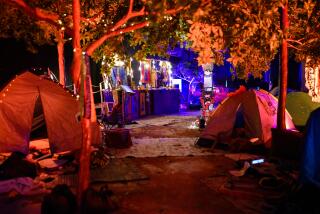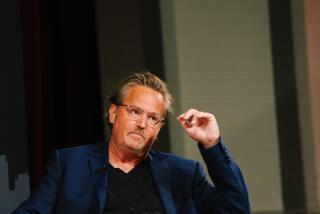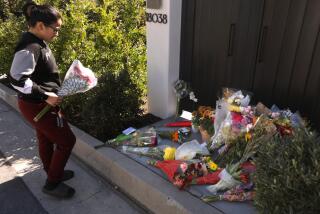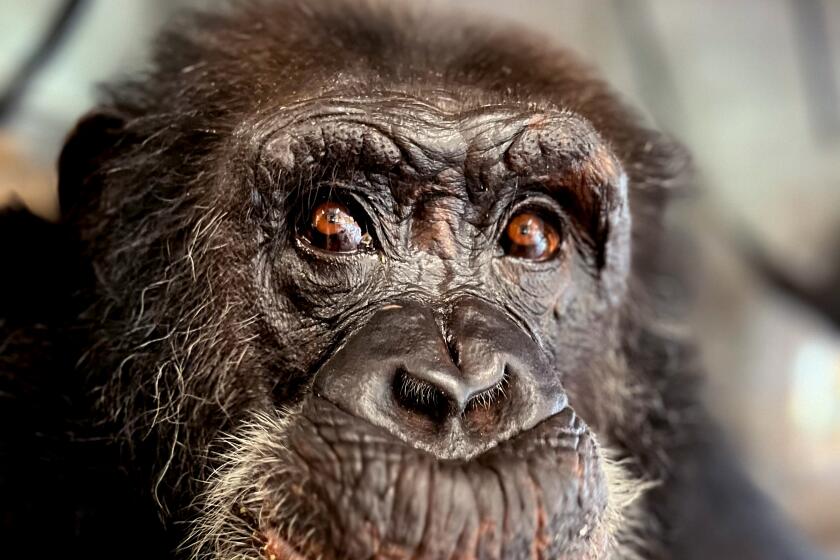Museum of Death in L.A. buys Kevorkian suicide device Thanatron
The Thanatron, a lethal contraption built by Jack Kevorkian to expedite assisted suicides -- earning him the nickname “Dr. Death” -- is now at possibly the only museum that would relish showing it.
That’s the Museum of Death in Hollywood, which is nearing its 20th anniversary of marshaling memorabilia of mortality for the public’s entertainment and edification -- at least that portion of the public that has the stomach for it.
The Thanatron came on the market last spring at Gallerie Sparta in West Hollywood, which showcased it along with about a dozen of Kevorkian’s oil paintings.
The Museum of Death’s co-founders and proprietors, J.D. Healy and Cathee Schultz, are now the proud owners of the Thanatron and one of the paintings, “Fever,” in which a grimacing man’s see-through torso glows red. He doesn’t appear to be dead but clearly is suffering. Kevorkian designed the Thanatron to release chemicals from tubes hung from a simple, clunky-looking frame. The device would deliver a painkiller, then a lethal infusion with just a push of a button.
“It should be in the Smithsonian,” Healy said.
Instead it’s in Hollywood, but perhaps not for long. Healy and Schultz, who are married, plan to open a New Orleans branch of their museum this fall, and the Thanatron is pegged to reside there for a good while.
Before it leaves, Healy said, the exhibit of Kevorkiana he’s developing will open in September for a couple of weeks in L.A. The show might include a related acquisition Healy said he’s now considering, despite its impracticality for indoor display: the white 1968 Volkswagen van where Kevorkian’s patients ended their lives using the Thanatron or the Mercitron, a companion device that Kevorkian designed to release fatal streams of carbon monoxide gas.
In reporting Kevorkian’s 2011 unassisted death from illness in a Detroit hospital, the Atlantic noted that the Mercitron saw considerably more use than the Thanatron.
Still, for Healy, it’s a prized display item that has more than a lurid appeal. He said it helps the museum fulfill what he considers the serious mission of getting people to focus now on what we’ll all face later.
He said the Kevorkian installation will ask museum-goers to consider whether what the doctor did was murderous or humane. “We’re not here to tell people what to think,” Healy said. “We’re here to give them information. Is it murder or is it suicide? That’s what museums are supposed to do -- ask the hard questions.”
Also on display will be the suitcase and wooden box in which Kevorkian transported the table-top sized Thanatron, and the medicine bag in which he carried his chemicals for people who no longer wanted to live because of extreme illness or disability. Kevorkian said he helped more than 130 people die from 1990 to 1998.
He was convicted of murder in 1999 for directly administering a lethal injection -- an exception to his usual approach of providing a device that his clients could operate themselves. Kevorkian served eight years in prison.
With a collection of more than 5,000 objects, photographs, documents and human remains -- among them the head of a French serial killer who was guillotined in 1922 -- Healy estimates the 4,000-square-foot Museum of Death can show no more than a third of its collection. The site in New Orleans’ French Quarter will be about three times larger, he said. The plan is to rotate exhibitions back and forth between the Museum of Death and Musee de Mort Orleans, as the Louisiana museum will be called.
Healy declined to say how much he paid for the Thanatron and the “Fever” canvas, or to say how many visitors the Museum of Death gets. It has been popular enough, he said, to earn a living and finance ongoing acquisitions.
The wares in Gallerie Sparta’s Kevorkian show were provided by his niece. Co-owner Lee Bowers said that seven of his paintings have been sold, fetching $12,000 to $40,000; four others remain on display, two of them macabre -- “Coma” and “The Brotherhood.” The others, portraits of Kevorkian’s father and Johann Sebastian Bach, show a more placid side.
“Leonardo DiCaprio and his dad came in to see [the show] privately,” Bowers said, noting that the actor “has become a very big collector of edgy outsider art, and Kevorkian falls into that category. He didn’t make an offer on any of them.”
Bowers said the Thanatron, which was shown in a Plexiglas case, had a discernible effect on the gallery’s visitors.
“They were real quiet when they realized it was the real one” that had been used in assisted suicides. “It definitely had a vibe, and people were somber.”
“The Museum of Death contacted us very early on” about negotiating a price for the Thanatron, she said.
The Museum of Death’s Kevorkian acquisitions aren’t on display yet. They probably won’t have as extreme an effect on viewers as some of its more graphic depictions of death. “Already this week we had two people pass out,” Healy said. “Everyone has different triggers,” he added, so it’s impossible to say which artifacts are the most powerfully gruesome. “I call it my falling-down ovation.”
The initials in J.D. Healy are for James Dean. Healy was born in 1961, six years after the actor died in a car wreck; his mother named him for the screen actor.
Now museum visitors can check out a copy of the speeding ticket issued to Healy’s namesake shortly before he fatally crashed his Porsche.
The Museum of Death’s other holdings include a simple bunk bed that it was one of the deathbeds in a 1997 mass suicide in which 39 members of a San Diego County cult called Heaven’s Gate poisoned themselves.
The museum’s most important possession is its name, Healy said. “That’s the magic right there. All these items and objects come to us because of the name.”
Follow @boehmm for arts news and features.
More to Read
The biggest entertainment stories
Get our big stories about Hollywood, film, television, music, arts, culture and more right in your inbox as soon as they publish.
You may occasionally receive promotional content from the Los Angeles Times.











